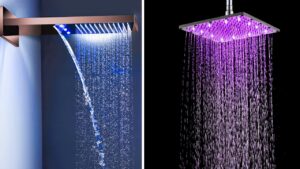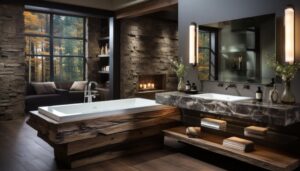Water conservation is a big deal when you’re choosing a shower faucet supplier, especially with everyone being so eco-conscious these days. As procurement officers, we need to think about sustainability to meet modern demands and keep costs down in the long run.
Choosing a shower faucet supplier with water conservation features is essential because it helps conserve water, promotes sustainable water management practices, and reduces utility bills. Low-flow fixtures, for example, limit water usage per minute, benefiting both the environment and homeowners.
Let’s dig into why water conservation matters and how it can help you make a better choice.
How to Choose a Faucet for a Shower?
When selecting a shower faucet, consider several key factors to ensure you make the best choice:
- Consider Water Pressure: Ensure the water pressure in your home is adequate for the desired faucet. This will guarantee optimal performance and satisfaction.
- Consider Your Budget: Balance the cost of the faucet with its features. High-quality, water-saving faucets may have a higher upfront cost but can lead to long-term savings.
- Match Your Accessories: Ensure the faucet design complements your existing bathroom fixtures for a cohesive look.
- Configuration Matters: Choose the right configuration (e.g., single-handle or dual-handle) that fits your preferences and bathroom setup.
- Valves for the Shower Faucet: Select appropriate valves to ensure efficient water flow and control.
Why are Water-Saving Devices Important?
Reduced Treatment Costs
Less water usage means lower costs for water and wastewater treatment, as well as reduced energy consumption. Treating and pumping water requires significant amounts of energy, and by reducing water consumption, we can decrease the demand for these processes. This not only lowers operational costs for water utilities but also reduces greenhouse gas emissions associated with energy production. Water-saving devices help alleviate the strain on municipal water and wastewater systems, extending their lifespan and reducing the need for costly infrastructure upgrades. This creates a more efficient and sustainable water management system for communities.
Economic Savings
By using less water, these devices help lower utility bills, providing significant savings over time. Households and businesses can see a noticeable reduction in their water expenses, which can be redirected to other essential needs or investments. Water-saving devices, such as low-flow faucets and showerheads, can reduce water usage by up to 50%, making a substantial difference in monthly utility bills. These savings are especially important in regions facing water shortages or high water costs, where conservation efforts can lead to more affordable living conditions.
What are Water Conservation Fixtures?
WaterSense Certified Products
Products labeled with the WaterSense certification meet strict performance criteria set by the EPA, ensuring both efficiency and effectiveness. WaterSense-labeled fixtures are independently tested and certified to use at least 20% less water than standard models without sacrificing performance. These products often include advanced technologies, such as pressure-compensating flow regulators, that maintain a steady flow rate regardless of water pressure fluctuations. By choosing WaterSense-certified fixtures, consumers can be confident that they are making a positive impact on water conservation efforts while enjoying high-quality performance.
Low-Flow Fixtures
These fixtures conserve freshwater resources, reducing the strain on water supplies and promoting sustainability. They also lower utility bills by reducing the amount of water used and heated. Low-flow fixtures include aerators that mix air with water to maintain pressure while using less water, and flow restrictors that limit the water flow rate. These technologies ensure that users still experience strong water pressure, but with significantly reduced water consumption. The widespread adoption of low-flow fixtures can lead to substantial water savings at both individual and community levels.
What is a Good Water Flow Rate for a Shower?
Standard Shower Heads
Typically use 2.5 gallons per minute (gpm). While this flow rate provides a strong, comfortable shower experience, it can result in significant water usage over time. Reducing the flow rate can lead to substantial water savings without compromising the quality of the shower. For instance, a ten-minute shower with a standard showerhead can use 25 gallons of water, whereas a water-saving showerhead can cut this usage by nearly half.
WaterSense Labeled Product
Use no more than 2 gpm while meeting performance requirements. Installing these can save the average family 2,900 gallons of water per year. WaterSense-labeled showerheads are designed to provide a satisfying shower experience while using significantly less water. They achieve this through innovative designs that optimize water distribution and pressure. The reduction in water usage also translates to lower energy costs, as less hot water is required, leading to savings on both water and heating bills. Over time, these savings can add up, making WaterSense-labeled products a smart investment for any household.
Benefits of Water-Saving Shower Faucets
- Reduced Water Usage: Lower water consumption directly translates to lower utility bills. Water-saving faucets can significantly reduce household and commercial water usage, leading to substantial financial savings over time.
- Environmental Conservation: Contributes to preserving water resources and reducing the environmental impact. By using less water, these fixtures help protect natural water bodies, reduce greenhouse gas emissions associated with water treatment, and support global water conservation efforts.
- Sustainable Water Management: Promotes responsible water use and management practices. Implementing water-saving technologies in homes and businesses encourages a culture of sustainability, helping to ensure that water resources are available for future generations.
- Enhanced Property Value: Eco-friendly features can increase the appeal and value of properties. Homes and commercial properties equipped with water-saving fixtures are more attractive to environmentally conscious buyers and can command higher resale values.
- Improved Utility Performance: Efficient water use reduces the burden on municipal water and wastewater systems, leading to improved performance and reduced infrastructure costs. This can result in lower taxes and fees for residents and businesses.
- Health and Safety Benefits: Water-saving fixtures often include features that improve hygiene and safety, such as touchless operation and built-in filtration systems. These features can enhance the overall user experience and promote healthier living environments.
Water-Saving Technologies in Shower Faucets
Aerators
Mix air with water to maintain pressure while using less water. Aerators are small devices that attach to the end of a faucet, creating a mixture of air and water that results in a steady, high-pressure stream while reducing water flow. This technology allows users to enjoy a powerful shower experience without using excessive amounts of water. Aerators are easy to install and can be added to existing faucets, making them a cost-effective solution for enhancing water efficiency. They are available in various flow rates, allowing consumers to choose the level of water conservation that best meets their needs.
Flow Restrictors
Limit the amount of water flowing through the faucet, reducing usage without sacrificing performance. Flow restrictors are designed to control the flow rate of water, ensuring that only the necessary amount is used. These devices can be integrated into the faucet design or added as aftermarket accessories. By maintaining optimal water flow, flow restrictors help conserve water while providing a satisfying shower experience. They are particularly useful in areas with strict water usage regulations or where water conservation is a priority. Flow restrictors can be used in conjunction with other water-saving technologies to maximize efficiency.
Smart Showers
Utilize technology to monitor and optimize water usage, ensuring efficiency. Smart showers feature advanced sensors and controls that allow users to customize their shower experience while minimizing water waste. These systems can track water usage, adjust flow rates, and even shut off the water when not needed, such as during soaping or shampooing. Some smart showers also offer features like programmable settings, voice control, and integration with smart home systems. By providing precise control over water usage, smart showers enable users to conserve water effortlessly while enjoying modern conveniences. These technologies represent the future of water-saving innovations in the bathroom.
Cost Savings with Water-Saving Faucets
Lower Water and Energy Bills
Reduced water and energy consumption lead to significant savings over time. By using less water, households and businesses can lower their utility bills, freeing up resources for other expenses or investments. The savings on energy bills are also notable, as less hot water is required, reducing the cost of heating water. Over time, these cumulative savings can make a substantial difference in the overall cost of living or operating a business. The initial investment in water-saving faucets can be quickly offset by the ongoing reduction in utility expenses, making them a financially smart choice.
Reduced Maintenance and Replacement Costs
High-quality, durable fixtures require less frequent maintenance and replacement. Water-saving faucets are often designed with advanced materials and technologies that enhance their longevity and reliability. This durability translates to fewer repairs and replacements, reducing the overall maintenance costs. Additionally, the efficient use of water helps prevent issues such as mineral buildup and corrosion, which can damage plumbing systems over time. By investing in high-quality water-saving faucets, consumers can enjoy long-term performance and reliability, minimizing the need for costly maintenance and replacements.
Incorporating water conservation features in your shower faucet selection is not only beneficial for the environment but also reduces long-term costs. Choosing the right supplier can lead to sustainable and cost-effective solutions for your projects.




